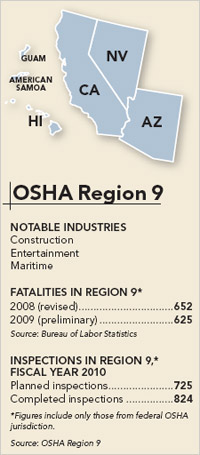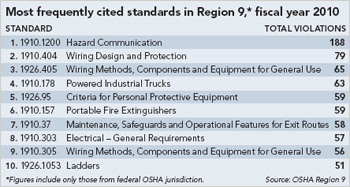Improving relationships
Region 9 works hard to maintain a good relationship between federal OSHA and states
By Kyle W. Morrison, senior associate editor
In OSHA’s Region 9, a good and close relationship with the states is a must.
Every state in the region – Arizona, California, Hawaii and Nevada – operates its own occupational safety and health program. But events in recent years highlighted that the working relationship between the states and federal OSHA was perhaps not as close as it needed to be.
safety and health program. But events in recent years highlighted that the working relationship between the states and federal OSHA was perhaps not as close as it needed to be.
Following a series of workplace deaths at large construction sites in Nevada, an OSHA report revealed serious problems with that state’s program. The report, in turn, prompted a federal review of all State Plan states in the country.
The results of the review were not entirely positive, and some reports were scathing – Hawaii’s OSH program was singled out to possibly have jurisdiction returned to federal hands. These findings caused some initial friction between the region and the states, according to Ken Atha, administrator for Region 9.
Prior to the reports, Atha said, a relationship between the states and Region 9 “wasn’t there.” Now the relationship is changing. Improvements being made in Region 9 include focusing more on oversight, as well as establishing additional offices in the states and placing senior leadership in each state. Previously, Nevada and Hawaii had to contact federal OSHA’s San Francisco office when they had issues, something Atha called a “barrier.”
Now the states are making progress on improving their State Plans – with federal OSHA’s help.
Working together
That help goes both ways: Several State Plan states have promulgated standards that federal OSHA is considering for adoption.
“[Federal OSHA] can’t make sweeping changes; it’s a long process,” Atha said. “The states have the luxury to deal with … the industries limited within the states.”
Because of this, states can put forth new standards at a faster pace than federal OSHA, and the states in Region 9 have been very active.
For example, while federal OSHA wrestles with how to formulate an Injury and Illness Prevention Standard, California, Nevada and Hawaii have had one for years. So when federal OSHA began looking into how to develop a national standard, they examined what the Region 9 states were doing. Additionally, when federal OSHA began its heat-stress awareness program this past summer, staff from California – which has a heat illness prevention standard – worked with the federal government to develop guidance materials.
 Jurisdiction
Jurisdiction
Although State Plan states have primary control over occupational safety within their borders, federal OSHA sends out its own inspectors to sites within various industries. In California and Hawaii, many maritime operations fall under federal jurisdiction. Likewise, many military operations in the states are exclusively federal, although some have mixed jurisdiction.
Atha admits that determining the jurisdiction of a particular site can be difficult, and sometimes a state program will begin working a case before realizing it belongs under federal jurisdiction. He said some employers appealing a citation before an administrative law judge will argue a lack of proper jurisdiction, so State Plan states and federal OSHA have to work together to avoid the possibility of a case being thrown out.
Region 9 also oversees several U.S. territories, including Guam and American Samoa. While many of the OSHA regions in the country must travel several hours to an inspection site, Region 9 staff has the unusual distinction of having to cross the international date line to travel to some inspection sites. This presents its own challenges – dealing with inspecting areas literally a day away and in an environment in which several different languages are spoken. To address these problems, Atha said OSHA hires staff members with multilingual skills and often sends them to the territories to maintain a presence in the area.
Post a comment to this article
Safety+Health welcomes comments that promote respectful dialogue. Please stay on topic. Comments that contain personal attacks, profanity or abusive language – or those aggressively promoting products or services – will be removed. We reserve the right to determine which comments violate our comment policy. (Anonymous comments are welcome; merely skip the “name” field in the comment box. An email address is required but will not be included with your comment.)

